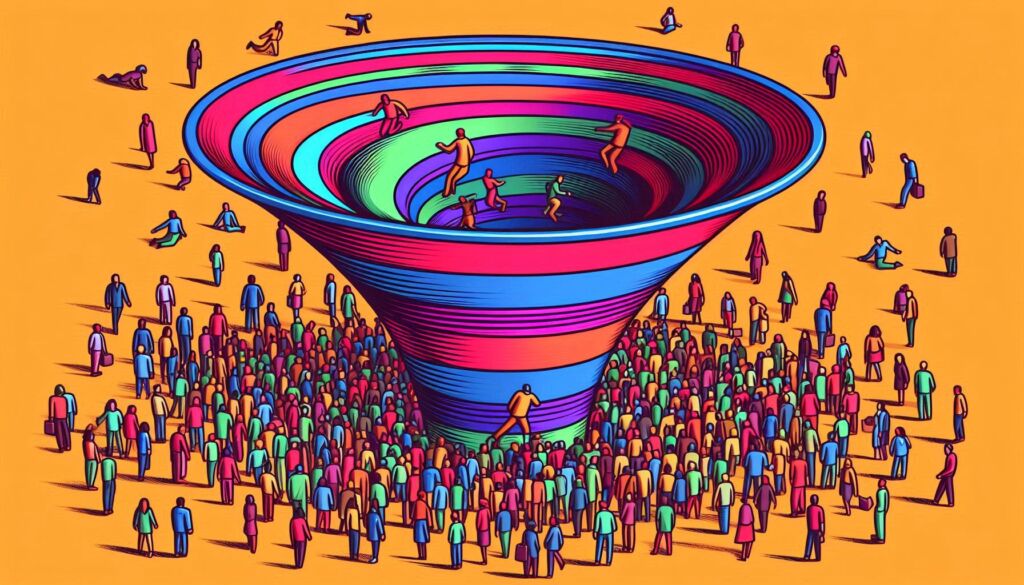Mind the Funnel: When Advertisers Are the Conversion
by Shirley Marschall on 16th Jul 2025 in News

In her latest ExchangeWire column, Shirley Marschall ponders on the complexities of the advertising funnel, and the need to simplify the ad tech stack.
You thought you were running the funnel? You’re in It.
Advertisers love to talk about funnels - awareness, consideration, conversion. But in ad tech, they’re not just running the funnel. They’re the ones being converted.
Big tech sets the beat. Agencies repackage the playbook. Advertisers? They scramble to stay relevant, prove they’re first movers, and nod like they know where the budget’s going…even when they don’t (always).
The irony? The same mechanics brands use to convert customers - urgency, complexity, the illusion of control - are being used on them.
Every shiny tool is a call to action.
Every acronym is friction.
Every whitepaper is a retargeting ad for your strategy.
And it works! Oh, how well it works…
The industry that solves its own problems: By creating more
"Technology is an engine for problems — both solving them and creating new ones."
Ad tech has LITERALLY turned that sentence into a business model.
Every year, the ecosystem births a new solution: to fix targeting, to fix measurement, to fix identity, to fix attention. But none of these "fixes" replace what came before. Instead, we layer. We patch. We rename. We stack a new solution on top of an old one for a problem we half-solved two years ago.
Clicks, views, attention - just measure them all!
We started with tracking clicks. Then came views. Then ROAS, incrementality, MMM, and attention scores. Add in brand lift, MTA, and every "proprietary" KPI ever pitched. Not one of these was retired. We don’t simplify. We accumulate. The result? Contradictory dashboards, messy optimisation, and still no unified definition of success.
Cookies, IDs, clean rooms - throw them all in the blender!
We started with cookies. Now we juggle first-party, second-party, third-party data. Universal IDs, hashed emails, contextual signals, clean rooms, CDPs, DMPs. What was meant to streamline targeting now looks like a data taxonomy war zone. And yet, we keep stitching new patches onto a foundation that never really worked.
Formats? We never kill them - we just keep adding!
Banners. In-stream. Native. Shoppable. Immersive. DCO. CTV. DOOH. No format is ever declared obsolete, because someone, somewhere, might still be monetising it. So we run everything. Measure everything. Optimise everything. And somehow, effectiveness remains a mystery.
We already know some things don’t work.
Banner blindness? Proven for years, yet banners dominate every screen.
Clicks? Still a KPI, even though they mean almost nothing.
Third-party cookies? Unreliable since day one, now framed as a "win" because they’ve survived a little longer.
And then there are the likes of X: a brand safety disaster by any definition, yet advertisers keep spending, nudged by incentives and bundled deals. Why? Because risk gets ignored when rewards get optimised.
Is the goal of this to turn everything and everyone in circles until no one has any overview of what’s actually happening? If so, well done!
Is the goal to spend ad money in the best way? Mission failed.
We don’t fix what’s broken.
We routinise it.
Then we optimise it.
Then we rename it.
And eventually, we forget how broken it ever was.
The real problem isn’t tech. It’s the incentives.
"Technology is an engine for problems — both solving them and creating new ones," captures the engine. But it’s the "Too often, the ones diagnosing the problem are the ones selling the solution" perspective that explains why the engine keeps running.
Big tech defines the identity "crisis" - then sells the clean room.
Agencies highlight complexity - then sell the strategic team to decode it.
Measurement vendors question your KPIs - then offer a new one (with the same blind spots).
Advertisers? They’re left to nod, spend, and hope someone else is keeping track. Complexity breeds dependency. Confusion justifies consulting. Obfuscation protects profit.
Simplifying rarely pays. But translating the chaos you helped design? That’s a service.
It’s like going to a doctor who invents a disease just to sell the cure.
The incentive to confuse
There is little commercial incentive to make things simple.
Complexity creates dependency.
Confusion justifies consulting fees.
Opacity preserves margin.
And new shiny tools keep the conversion funnel running.
In this system, transparency becomes a threat, not a value.
And simplicity? That’s a startup pitch deck. Not a business model.
Everyone talks about FOMO…
…but maybe the real challenge is FOLGO: fear of letting go.
Yes, innovation is what moves us forward. It’s what brought us from cave fires to cloud servers. But true innovation means knowing when to stop, not just when to add.
In ad tech, we fear being left behind. But what if the real risk is being dragged down by what we refuse to release?
Let go of legacy formats that no longer deliver.
Let go of KPIs that create noise, not insight.
Let go of acronyms that confuse more than they clarify.
Progress isn’t about stacking more tech. It’s about creating fewer excuses.
Time to clean the funnel
Advertisers, once you’ve been converted, it’s on you to break the cycle. That means treating your stack like a cluttered closet: every time you add something new, something old, cracked, or pointless needs to go. Not someday. Now.
You don’t need more acronyms. You need air.
You don’t need another fix. You need a filter.
Because if every new "solution" gets layered on top of the last - without ever asking what’s worth keeping - the funnel doesn’t just stay broken. It becomes the business model.
And that’s not a funnel worth staying in.









Follow ExchangeWire